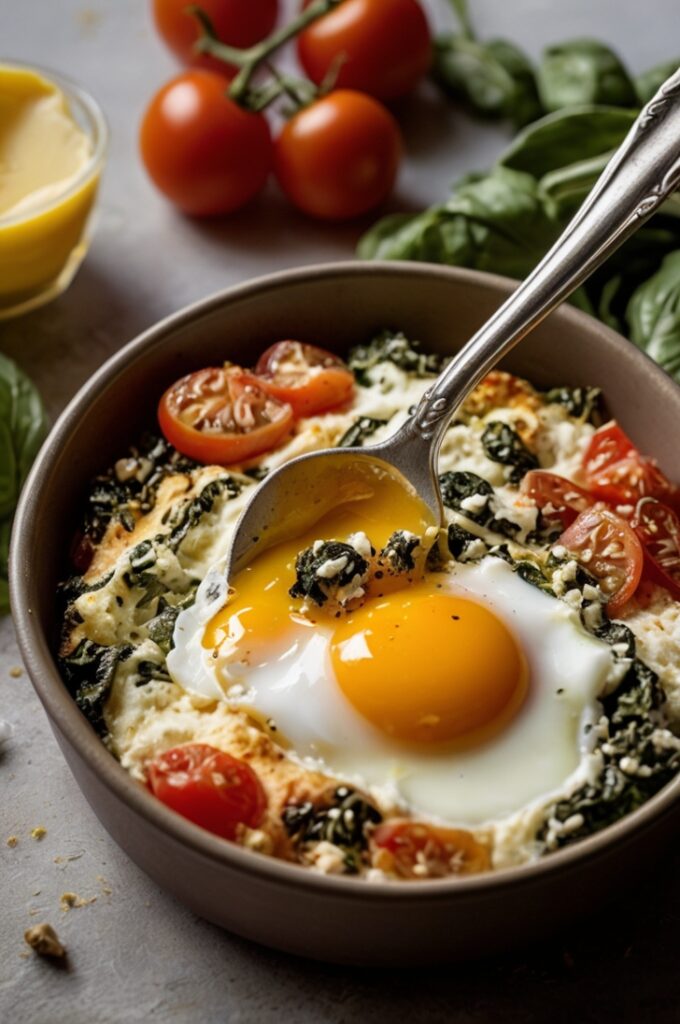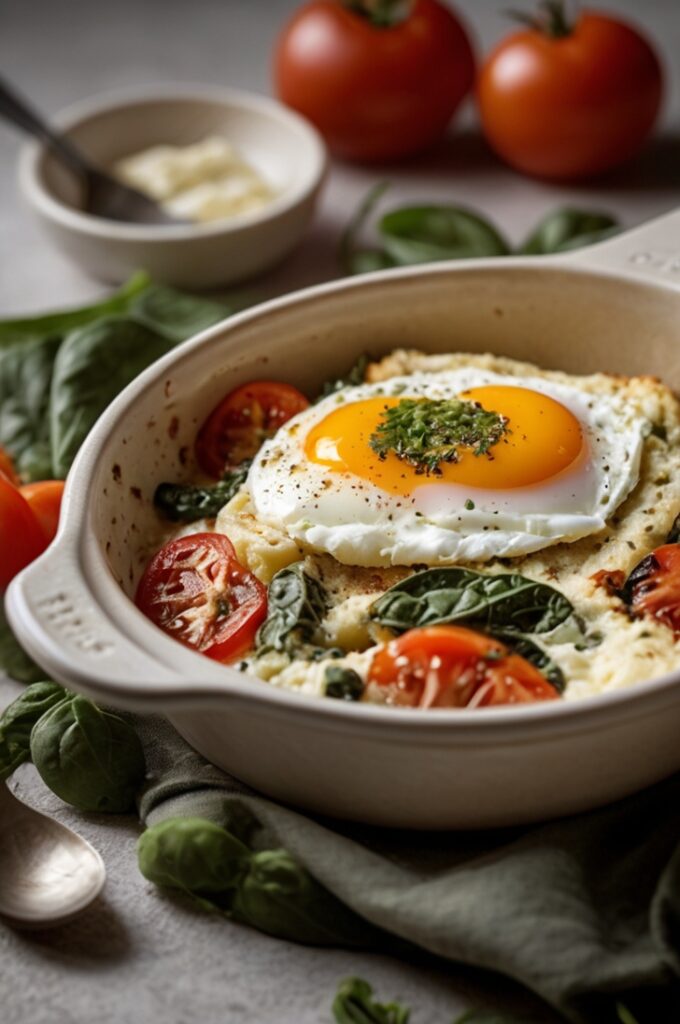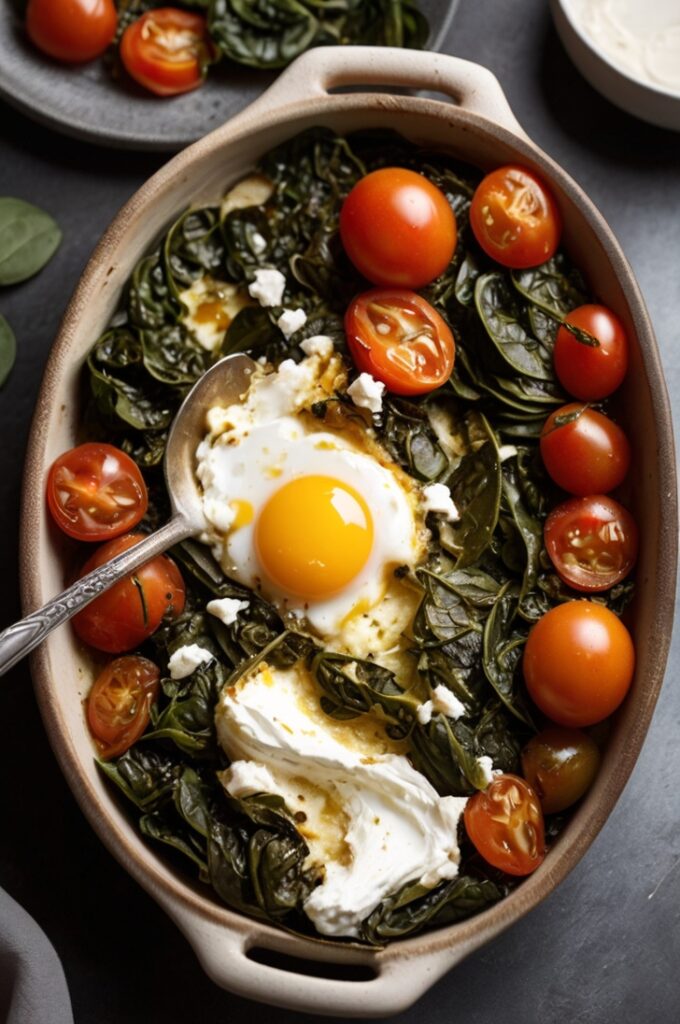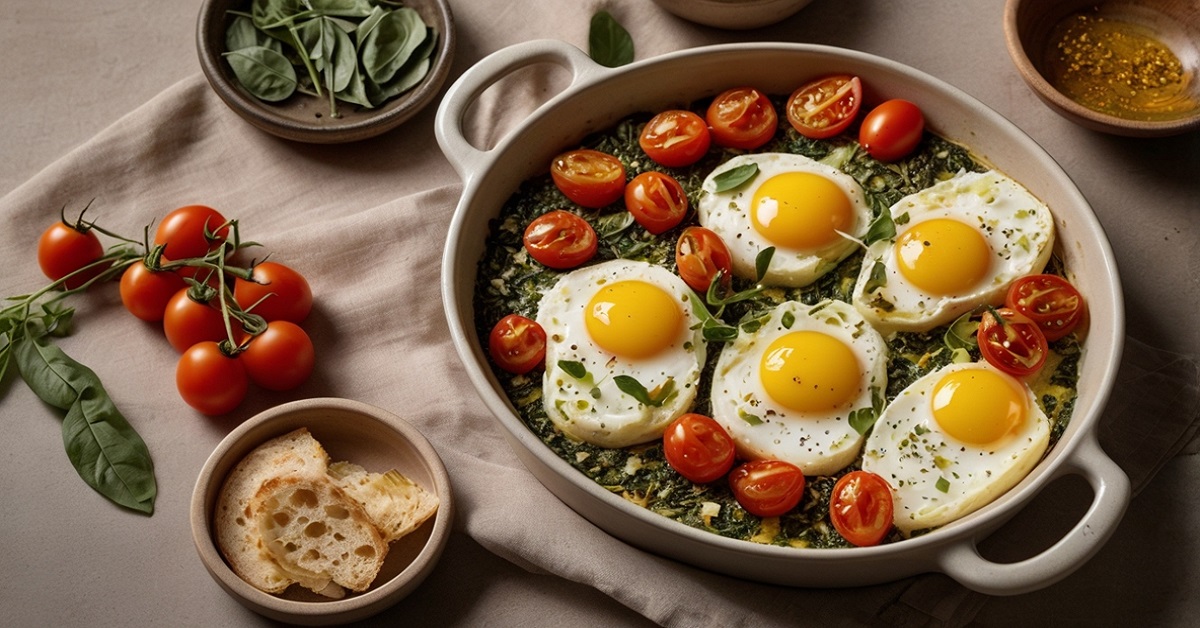Mediterranean Baked Feta Eggs changed everything I thought I knew about breakfast. The first time I baked eggs in a puddle of warm feta, olive oil, and blistered tomatoes, I nearly cried. Not from spice. From sheer joy.
I’d been chasing the perfect savory breakfast something warm, hearty, and just salty enough to make your eyes roll back. This was it. Honestly? It felt more like a revelation than a recipe.
The dish is stupidly simple. But don’t let that fool you. Like a good risotto or a proper omelet, the magic’s all in the how. Rich, creamy feta turns molten under the heat. Cherry tomatoes burst into jammy little explosions.
Eggs? Baked just right till the whites are set and the yolks jiggle like they’re about to say something poetic. The edges caramelize in olive oil, and suddenly your kitchen smells like a Greek grandma’s sunlit courtyard. It’s humble, cozy, and absurdly elegant all at once.
Ingredients & Substitutions

Here’s what you’ll need:
- 200g block feta cheese (preferably sheep’s milk)
- 1 cup cherry tomatoes (halved or whole your call)
- 3–4 large eggs (room temp, always)
- 2 tbsp good olive oil (extra virgin, peppery)
- 1 garlic clove, finely sliced (optional but recommended)
- ½ tsp crushed red pepper flakes
- Fresh thyme or oregano (a few sprigs)
- Sea salt (go easy feta brings the salt)
- Freshly cracked black pepper
- A handful of baby spinach or kale (optional)
Substitutions that won’t wreck it:
– No feta block? Crumbled works, just try not to use that sad, chalky supermarket tub. It melts differently less creamy, more rubbery.
– Can’t do dairy? Try firm tofu marinated in lemon juice and olive oil for 20 mins it’s not feta, but it’ll carry the vibe.
– Cherry tomatoes out of season? Use canned whole San Marzanos, just drain them a bit.
– Don’t love heat? Skip the chili flakes. But maybe add a pinch of smoked paprika instead for depth.
Use fresh herbs if you can. Dried oregano’s fine in a pinch, but fresh thyme brings out this woodsy aroma that makes the whole thing sing.
Step-by-Step Instructions
Preheat your oven to 190°C (375°F). You want it hot but not scorching this is gentle baking, not roasting.
1. Start with a small baking dish.
Something ceramic or enameled, around 6-8 inches across. Not too big you want the feta to pool and soften, not dry out.
Drizzle in the olive oil and scatter in your tomatoes and sliced garlic.
2. Add your feta.
Crumble it roughly or place the whole block in the center, nestled among the tomatoes. Don’t pack it too tight. Give it room to breathe and melt.
3. Season gently.
Sprinkle over the red pepper flakes, herbs, and a touch of salt and pepper. Remember, feta’s salty go easy unless you’re into mouthfuls of brine.
4. Bake uncovered for 10–12 minutes.
At this point, the tomatoes should be starting to blister and the feta just beginning to soften and brown at the edges.
5. Crack in your eggs.
Carefully. Like you’re placing little treasures. Try not to break the yolks. Spoon the tomatoes and feta around them to cradle the whites.
6. Return to oven for another 7–9 minutes.
You want just-set whites and yolks that are still runny. Overbake and you’ve got chalky sadness.
Tip: If the whites aren’t setting fast enough, switch to top broil for the last 2 minutes but watch it like a hawk.
7. Optional but delightful: Toss in a small handful of spinach or kale before adding eggs if you want greens.
Cooking Techniques & Science

So why bake the feta before the eggs?
Good question. Feta doesn’t melt like mozzarella or cheddar. It softens. Loosens. Becomes creamy when warmed gently.
If you throw the eggs in too soon, they’ll cook way faster than the cheese softens, and your timing’s all off.
Baking the cheese and tomatoes first builds the base. It gives the tomatoes time to concentrate liquidy tomatoes can ruin the set of your eggs if added cold.
Use whole eggs, not beaten.
We’re not making shakshuka. This isn’t a scramble. You want the yolks as little golden bombs waiting to be broken at the table.
And please, for the love of breakfast, don’t skip the olive oil. The fat not only prevents sticking but actually helps carry the heat into the cheese. It’s what gives you those sexy browned edges.
Also always use room temperature eggs. Cold eggs will tighten up and seize faster in the oven, and you’ll end up with rubbery whites and firm yolks. Yikes.
Serving & Pairing Suggestions
Straight from the oven, this dish looks rustic. A little messy. Like it just woke up. That’s the point.
Serve it right in the baking dish just plunk it on the table with a stack of warm flatbreads or crusty sourdough.
Spoon out portions with a little of everything: creamy feta, jammy tomato, soft egg, herbs, oil.
Top with chopped parsley or mint if you like. Add a few olives on the side. Or a dollop of Greek yogurt with lemon zest.
Drink pairing? Go herbal. A sharp mint tea. Or brunchy an Aperol spritz or a light white wine like Assyrtiko.
If it’s part of a spread, pair it with:
– A citrusy cucumber salad
– Roasted eggplant with tahini
– Labneh with sumac
– Spiced potatoes or herbed farro
Leftovers? Honestly rare. But if you have ‘em, spoon onto toasted bread and broil for an open-faced next-day thing.
Why This Dish Works (Cooking Science and Culture)

Feta eggs aren’t new. Versions of this exist all over the Mediterranean. Greece, Turkey, the Levant. The core idea’s the same cheese and eggs baked together in oil and tomatoes. Comfort food for the soul.
Scientifically, it’s about fat and acid balance. The feta brings salt and lactic tang. The oil adds richness. The tomatoes give brightness and umami. The eggs mellow it all out.
And the bake brings it all together. The oven acts like a low-and-slow conductor, coaxing every element to its best self.
Texture matters too. You’ve got soft egg, creamy cheese, bursts of tomato, crunchy toast. It hits every note.
Plus, it’s flexible. Feed one or feed a crowd. Make it fancy or keep it rustic. It’s endlessly riffable. And that’s what makes it real chef food not just pretty but practical.
FAQs About Mediterranean Baked Feta Eggs
1. Can I make this dish ahead of time?
Not really. The eggs won’t hold well once baked. You can prep the tomato-feta base in advance and just crack in the eggs when you’re ready to serve.
2. What if I don’t have an oven-safe baking dish?
Use a small skillet cast iron works great. Just be sure it’s oven-safe and not too large, or the eggs will spread too much.
3. Can I use other cheeses besides feta?
Sure. Halloumi won’t melt, but works in cubes. Goat cheese is creamier and tangier. Ricotta’s too wet unless baked down first.
4. How do I keep the egg yolks from overcooking?
Watch your timing. Pull the dish when whites are just set. You can also tent the dish with foil if the top’s cooking too fast.
5. Is this gluten-free?
Yes just watch what you serve it with. Bread’s the usual pairing, but GF pita or roasted potatoes work great too.
Final Tips & Tricks
– Use a small baking dish. Bigger means everything spreads and dries.
– Keep an eye on your eggs. Ovens vary. Peek at 6 minutes.
– Add a pinch of za’atar or Aleppo pepper if you want something extra fragrant.
– Don’t skimp on the oil. It’s not a garnish it’s a cooking medium.
– Serve immediately. This isn’t a dish that likes to sit around.
It’s perfect brunch food. But honestly, I’ve made it for dinner more times than I care to admit. With a glass of cold white wine, feet up, and maybe some jazz in the background. It’s hard to beat.




